
Applications of Op Amp
Introduction: Applications of Op Amp
Op-amps have become an integral part of almost every electronic circuit which uses linear integrated circuits. They are used in the fields of process control, communications, computers, power and signal sources, displays and measuring systems. In this article lets discuss Applications of Op amp.
What is an Op Amp?
An operational amplifier, or op-amp, is the most important and versatile analog IC. It is a direct coupled multistage voltage amplifier with an extremely high gain. With the help of opamp, the circuit design becomes very simple. The variety of useful circuits can be built without the necessity of knowing about the complex internal circuitry.

Applications of Op Amp
- Op-amps have become an integral part of almost every electronic circuit which uses linear integrated circuits.
- They are used in the fields of process control, communications, computers, power and signal sources, displays and measuring systems.
- Some of the more common applications are: as a voltage follower, selective inversion circuit, a current-to-voltage converter, active rectifier, integrator, a whole wide variety of filters, and a voltage comparator.
We will consider the following Applications of Op amp
- As scalar or linear (i.e., small-signal) constant-gain amplifier both inverting and non-inverting,
- As unity follower
- Adder or Summer
- Subtractor
- Integrator
- Differentiator
- Lastly as Comparator.
Applications of Op Amplifier
Op Amp applications as Inverting Amplifiers
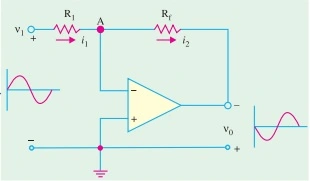
It is seen from above, that closed-loop gain of the inverting amp depends on the ratio of the two external resistors R1 and Rf and also is independent of the amplifier parameters. OP-AMP works as a negative scaler. It scales the input i.e., it multiplies the input by a minus constant factor K
Op Amp Applications as Non Inverting Amplifiers
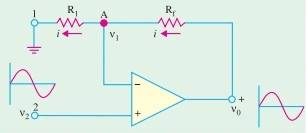
This circuit is used when there is need for an output which is equal to the input multiplied by a positive constant. Such a positive scaler circuit which uses negative feedback but provides an output that equals the input multiplied by a positive constant is shown in Fig. Since input voltage ν2 is applied to the non-inverting terminal, the circuits is also called non-inverting amplifier
Applications of Op amp as Unity follower
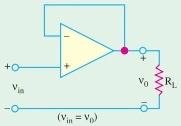
Lets see the application of Op amp as Unity follower. It provides a gain of unity without any phase reversal. It is very much similar to the emitter follower except that its gain is very much closer to being exactly unity. This circuit is useful as a buffer or isolation amplifier because it allows, input voltage νin to be transferred as output voltage ν0 while at the same time preventing load resistance RL from loading down the input source. It is due to the fact that its Ri = ∞ and R0 = 0.
R1 = Rf = 0
Applications of Op amp as Adder or Summing Amplifier
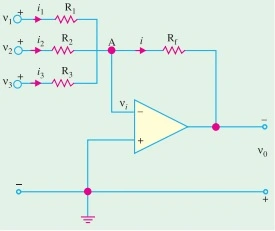
The adder circuit provides an output voltage proportional to or equal to the algebraic sum of two or more input voltages each multiplied by a constant gain factor. It is basically similar to a scaler except that it has more than one input. Fig. shows a three-input inverting adder circuit. As seen, the output voltage is phase-inverted.
Applications of Op Amplifier as Subtractor

The function of a subtractor is to provide an output proportional to or equal to the difference of two input signals. As shown in Fig. we have to apply the inputs at the inverting as well as noninverting terminals.
Op Amp Applications as Integrator

The function of an integrator is to provide an output voltage which is proportional to the integral of the input voltage.Lets see in detail.
Op Amp as Integrator
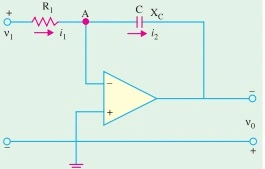
A simple example of integration is shown in Fig where input is dc level and its integral is a linearly-increasing ramp output. The actual integration circuit is shown in Fig. This circuit is similar to the scaler circuit of Fig except that the feedback component is a capacitor C instead of a resistor Rf
Applications of Op Amplifier as a Differentiator
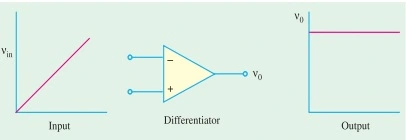
Its function is to provide an output voltage which is proportional to the rate of the change of the input voltage.
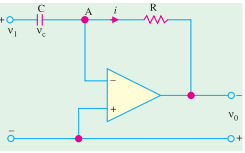
It is an inverse mathematical operation to that of an integrator. As shown in Fig. when we feed a differentiator with linearly-increasing ramp input, we get a constant dc output.
Op Amp application as a Comparator
It is a circuit which compares two signals or voltage levels. Lets see in detail.

Op Amp as Comparator
The circuit is shown in Fig and (like that of the unity follower) is the simplest because it needs no additional external components. If ν1 and ν2 are equal, then ν0 should idealy be zero. Even if ν1 differs from ν2 by a very small amount, ν0 is large because of amplifier’s high gain. Hence, circuit of Fig. 68 can detect very small changes which is another way of saying that it compares two signals.
LIKE WHAT YOU’RE READING?
CHECK OUT SOME OF OUR OTHER GREAT CONTENT HERE:
- LVDT- CONSTRUCTION, WORKING PRINCIPLE , APPLICATIONS, ADVANTAGES, AND DISADVANTAGES
- SCR VI CHARACTERISTICS EXPLAINED IN DETAIL
- STEP UP TRANSFORMER: DEFINITION, CONSTRUCTION, WORKING & APPLICATIONS
- LIMITATIONS OF OHM’S LAW
- INDUCTION MOTOR: WORKING PRINCIPLE, TYPES & APPLICATION
- STRAIN GAUGE WORKING PRINCIPLE
- WHAT IS THE ZENER DIODE? – EXPLAINED
- WHAT IS OPERATING SYSTEM AND ITS TYPE
- WHAT ARE THE USES OF CAPACITOR
- HOW AN IGBT WORKS?
- VARIOUS USES OF A RESISTOR
- HOW THE MOSFET WORKS?
- POWER FACTOR IMPROVEMENT METHODS
- WORKING PRINCIPLE OF SYNCHRONOUS MOTOR
- SYNCHRONOUS MOTOR STARTING METHOD
- WHY THE SYNCHRONOUS MOTOR IS NOT SELF STARTING
- WHAT IS A UNIVERSAL MOTOR ?




2 Comments